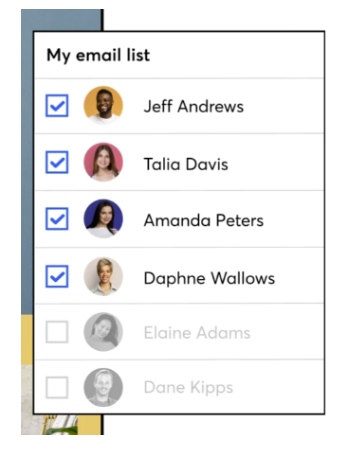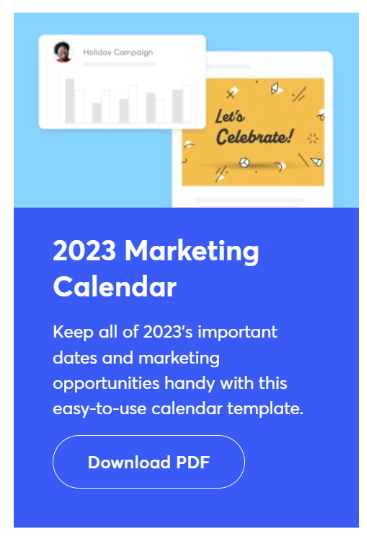
Even with the advent of social media and paid advertising, email remains at the heart of a successful marketing strategy. Putting together a quality email list will help you make sure you have offline access to an audience of interested and engaged patrons and potential customers. Releasing your business from the dependencies that come from storing followers with social networks. Use the following strategies to help you build your business’ email list and take note of the best practices to keep your lists clean and filled with active and engaged recipients.
What is an email list?
An email list is a collection of contacts who have given their permission to receive email communications from your organization. An email list might include: customers, organization members, donors, potential clients, vendors, business partners, or any number of contact groups who are interested in learning more about or communicating with your organization.

Why you want to create an email list
Building a healthy email list will help you grow interest in your organization as well as promote desired actions like purchases and donations. In fact, “more than 90 percent of survey respondents say email marketing is important to their company’s overall success.” Being that the vast majority of businesses believe that email marketing is pivotal to their success, it proves that the tactic is a worthwhile investment.
How to create an email list
Almost everyone’s inbox is constantly bursting and it is safe to say that the majority of people aren’t too excited to add another email subscription to their inbox. But as an owner or employee you know that your email marketing list is a powerful tool to support the success of your business. So your challenge is to think of clever and creative ways to ask for an email address. You want people to be excited to hear from you, so you need to think of what will spark interest, promote value, and altogether make people excited to be in conversation with your business. The good news is that we already did some of the work for you on that front.
Once you collect email addresses for your business’ generalized list, be sure to think about your email marketing goals to help you properly segment your contacts into specialized lists to support targeted email efforts like product-focused emails, birthday messages, etc.
Strategies to build your email list
Utilizing the following strategies can help you build your email list, whether you’re starting from scratch or building on what you already have.
Create a signup form
Place a visually appealing sign up form on a key page(s) of your website. A good example of places to embed a sign-up form include the front page of your website, at the end of a blog post, in the footer navigation, and on a contact page. Be sure to include valuable content and a call to action (CTA) which encourages your audience to complete the form. Include capture fields for relevant information like name, email address, and other need-to-know contact information. If you want to include capture fields for information that isn’t necessary, be sure to include asterisks to indicate that the fields are not required.
Site building integrations and other tools, like the Constant Contact Forms plugin for WordPress, can make creating a signup form for your site quick and easy.

Create an exit pop-up
Sometimes you need a last ditch effort to keep an audience interested in your business. This is where the exit pop-up comes into play. A general pop-up is a successful tactic to use to help you capture subscribers, “consider that the average conversion rate for pop-up forms is just over 3%, with the best pop-ups converting at around 10%.” (shopify) These percentages aren’t insignificant when it comes to building your email list, especially depending on the scale of your website’s overall traffic.
An exit pop-up, specifically, is a pop-up form that is shown to website visitors when they appear to have intention to leave your website. Exit intent could recognized through actions like:
- directing their cursor toward the exit button
- attempt to tab to another webpage
- scrolling up instead of down
Your exit pop-up should attempt to keep the visitor on the page or to complete the form to subscribe to your email list. (Here’s an example of a pop-up plugin commonly used on WordPress.)
Use social media
Social media brings your brand into the hands of your customers and potential clients…quite literally since the majority of people are checking in on the social sphere from their mobile device. Social media gives you a chance to make your brand personal and to exist in community with your followers. In terms of growing your email list — use social media to direct your audience. Promote a lead magnet, products, and services on your business social media accounts to direct traffic to your website and to capture email subscriptions.
Run a contest or giveaway
Everyone loves a free gift or a chance to win a coveted prize. Promote a high-value product or service from your business on social media and direct interested participants to your email sign-up. Encourage followers to share contest and giveaway information with friends and family by providing additional entrees or other sources of value in exchange for their help promoting your business.
Collaborate with an influencer
Influencers hold a lot of power in the business world. Forming a business relationship with a quality influencer in your industry or community can be incredibly beneficial. They can help you reach a wider audience and lend credibility to your brand image. Work with an influencer to promote your email list through streamed product trials, blog reviews of goods and services, and professional product photography. #sponsored #ad
Paid social and search ads
Consider investing in paid social media and search ads to drive traffic to your sign-up forms. Place ads on social networks like Facebook, Twitter, and Instagram and on search engines like Google and Bing. Paid social media ads work in a similar manner to organic social content with the added bonus that are guaranteed to reach your target audience. Whether your target audience engages with the content is not guaranteed, but the likelihood is higher than through organic means.
Create a lead magnet with gated content
Most people are pretty protective of their personal information, that’s why they won’t give their email or phone number away without knowing the organization they are giving it to is credible and can provide them with value. A lead magnet is a great way to interest potential subscribers by providing them with a valuable piece of content in exchange for their email address. Common lead magnet content can include: an ebook, whitepaper, checklist, etc.
Gating content is a method of placing a barrier (a sign-up form) on high-value, high-converting content. Gated content is downloadable and requires an exchange of an email address to be accessed.

Implement a referral program
Never underestimate the power of word of mouth marketing, especially when it comes to referrals. People trust those close to them to lead them in the right direction, so a friend or a family member giving a potential client a positive opinion of your business carries a ton of significance. Incentivize referrals by providing discounts, product trials, and other types of value to the referrer (to the referee, too, if you have the means).
Offer an incentive
Consider offering discounts, access to exclusive sales, and free products or trials to encourage people to sign-up for your email list. Potential subscribers are more likely to exchange their contact information when they receive something of value in return.
Optimize a sign-up form
Remove as many barriers as possible to make sure that the experience of subscribing to your business’ email list is easy and only asks for necessary information. As a rule of thumb, your business should only require information from customers that is relevant to your business and the content you plan to offer. Email is the minimal amount of information your business is likely to ask for, however you might also ask for first and last name, date of birth, and which business location they frequent (if your business has multiple locations).
Leverage customer testimonials
Positive reviews from past customers are extremely helpful in gaining credibility for your business. Gather customer feedback via surveys, comment boxes, and through in-store and online interviews with customers. Use customer testimonials as a lead into your email marketing subscription form.
List building tools
Build your email list with the help of useful tools and integrations.
Text-to-join
Allow subscribers to easily join your list through text-to-join. Provide subscribers with a mobile number for your business and ask them to text the number ‘Join’ and include their email address to be added to your business’ email marketing list.
Integrations
Customize customers’ interactions with integrations to include a checkbox to signup to your email list. When customers check out from your ecommerce website or use another integrated tool they can easily give their permission for you to collect their email addresses for marketing purposes.
Collect business cards
Event attendees may give you their business card. If they do, ask them if they would like to be added to your business’ email marketing list. Do not automatically assume that a business card equals an email marketing subscription. There is the scenario where the person wants to be in contact with your business for inquiries, partnership, sponsorship, etc. and not as a potential customer. Ask to be sure by sending a one-time welcome email to introduce your business and request the recipient to join your marketing email list.
Offline list-building tactics
Remember that offline events, conversations, and interactions with clients are also good ways to build your list. Attend industry events, collect business cards, and place a sign-up form in your brick and mortar store.
Attend and host industry events
Attending and hosting industry events is not only good for building your business’ brand credibility but also for building recognition and intrigue. Participate in trade shows, conferences, webinars related to your niche, or host your own events to showcase your expertise and then collect email addresses by offering valuable resources or exclusive event-related content. To make the process quick and easy for event attendees, place a QR code linked to your email subscription form in printed materials such as business cards, brochures, flyers, and posters.
Offline list-building tactics
Remember that offline events, conversations, and interactions with clients are also good ways to build your list. Attend industry events, collect business cards, and place a sign-up form in your brick and mortar store.
Attend and host industry events
Attending and hosting industry events is not only good for building your business’ brand credibility but also for building recognition and intrigue. Participate in trade shows, conferences, webinars related to your niche, or host your own events to showcase your expertise and then collect email addresses by offering valuable resources or exclusive event-related content. To make the process quick and easy for event attendees, place a QR code linked to your email subscription form in printed materials such as business cards, brochures, flyers, and posters.
Never buy email lists
As best practice for communicating with an interested and engaged audience, as well as for legal purposes: never purchase an email list. Buying an email list does not count as individual consent from subscribers. Buying an email list and sending communications to unconsenting individuals is spam and will cause emails to bounce. This type of practice can cause negative results for your business by damaging your credibility and giving you a false sense of the number of people who are actively interested in what your organization has to offer.
Email list segmentation
Email list segmentation is the process of creating individual email lists (separate from your general email list) based on specific factors that influence how, when, and why customers are receiving communications from your business. Segmented email lists make sure your customers receive personalized messages at the right time. Create segmented lists to support welcome email campaigns, personalized birthday messages, special offers, and more.
Build your business with a high-quality email list
Now that you know the tools and tactics to build a high-quality email list for your business, it is time to begin collecting eager subscribers. Create a landing page, publicize your email list on social media, and think about ways to provide your audience with value. Consider investing in an email service provider to keep your subscribers and content all in one place. As you build your list and begin sending communications, remember best practices like regularly reviewing and revising your list and to never purchase an email list. Happy list building!




